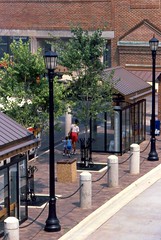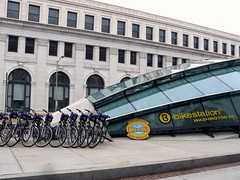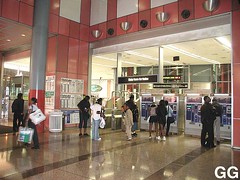The importance of transit context and design

Posted September 27, 2010 at 1:28PM
In almost all American communities, if public transit exists in any meaningful way, it competes for patronage, primarily though not exclusively with driving. While some advocates seem to believe that the best way to attract more riders to transit is to make driving increasingly as unappealing as possible through fees, removal of or restrictions on parking, “road diets” and the like, I’m not fully in that camp. There is an appropriate context for each of the things I just mentioned, but for the most part I want to make transit better so that customers choose it not just out of necessity but because it is easily accessible, comfortable, and efficient.
That’s where design comes in. Not just design, of course, but good design helps make transit work better. How convenient and safe is the Metro station or bus stop, for how many people? Is the carriage itself comfortable and pleasant? Are intermodal connections, transfer points, and major stations/stops good places to meet people or run an errand?
I have touched on this before, in a post about how “transit-oriented development” needs to be oriented to, not just placed near, transit. This is partly a function of the transit facilities, not only of the surrounding development, since sometimes the transit comes after the development, and in any case facility design can make it easier or harder to complement nearby development. Reconnecting America’s Station Area Planning Manual is an excellent look at the relevant issues.
In a different post, I praised the stunning design of Tempe, Arizona’s transit station, which is not only highly functional for transferring among buses, light rail, bicycling, and walking, but also beautiful and even exciting. When I wrote the post, the station was on track to receive a LEED-platinum rating, too. (I haven’t followed up to learn if the rating was awarded; the facility did win a smart growth award from EPA, though.)
My friend GB Arrington of PB Placemaking agrees. Writing on Planetizen, GB stresses that the issue of transit design deserves more federal attention and resources:
“Independent of mode, the design of transit facilities matters tremendously in capturing the economic development, environmental, land use and mobility benefits of transit investments. Not addressing design is a very big gap in the current federal program. The placement of a station, the size and location of commuter parking, how a transit facility fits into or is separated from a community each make a big difference on transit system performance.”
GB notes that there has been a great deal of conversation and a bit of progress on the design and context of roadways. Indeed, “context-sensitive” highway design is now a mainstream consideration with respect to how roads and streets interact with neighborhoods and communities. The “complete streets” movement, which is catching on just about everywhere, has without question elevated the issue of street design in planning offices all over the country. But GB believes this has happened only in isolated places (such as those shown in the images here), and certainly not at the federal level, with respect to transit:
“For too long the conversation has been about transit efficiency and what local governments can do to change land use. The attention needs to turn to improving transit design as well. Continuing to follow the old transit facility design playbook is not going to work if we want livable communities. As a first step [the Federal Transit Administration] needs to highlight the importance of good design to encourage transit agencies to deliver projects that embrace the principles of livable communities.”
As it happens, I was part of a meeting about neighborhood revitalization on Friday when the pending reauthorization of the omnibus federal transportation law came up. My partners questioned whether community issues were getting their due in that debate, even in the platforms of progressive organizations.
I will leave it to NRDC’s federal transportation policy experts to answer that one, but this particular aspect might not be that hard to address, even under current law. It certainly fits squarely within the US Department of Transportation’s commitment to sustainability. GB recommends that the Federal Transit Administration (a branch of DOT) at least “provide guidance, best practices, or require peer reviews to encourage a transit design process that supports livable communities,” and also provide incentives for transit authorities receiving federal assistance to take advantage.
That’s hard to argue with. Read his entire article here.
Move your cursor over the images for credit information.




